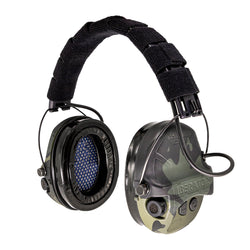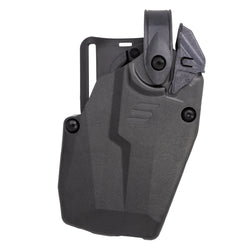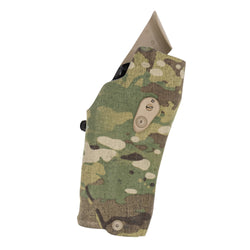Throughout its 250-year history, the US Army has fielded a wide variety of handguns. When circumstances dictate being armed but where a long gun would be unwieldy or unnecessary, a handgun is called for. But today, martial handguns are seen just as much as a badge of rank as a tool that is often carried, seldom used, and less capable than a long gun. But that was not always the view. Case in point: The Colt Walker.

The Walker Colt .44 caliber revolver put Samuel Colt on the firearms making map and gave the US Army its first fighting handgun. The Walker was the best and most powerful handgun available at the time, and it was even preferable to a rifle where it was used. Here is the history of the Colt Walker and how it shaped handguns for decades to come.
What Came Before: Exploring the US Army’s Early Handguns
When the Army was founded on June 14th, 1775, the most cost-efficient weapons platform was the single-shot muzzleloader. The preferred setup was the French Model 1763 .69 caliber smoothbore musket fed with paper cartridges and stoked with a bayonet. Weapons like these used undersized musket balls, which did not lend themselves to great accuracy but were meant for volume of fire.
Muskets like the French Charleville and British Brown Bess were hand-fitted weapons, but made to within specifications so that parts could interchange with minor fitting. By comparison, handguns were an afterthought.
Most handguns were large-bore smoothbore guns that could do damage, if a ball hit its mark. But most were single shot handguns intended for officers. In fact, most officers supplied their own personal handguns, so there was little uniformity. Cavalry pistols like the Model 1775 .62 caliber were more uniform, but it would not be until the adoption of the .58 caliber Harper’s Ferry pistol in 1805 did the Army have a standard issue sidearm.

The Model 1805 was a hard-hitting single-shot pistol. This style of handgun would remain in service for decades, with change only coming from the conversion of flintlocks to percussion cap ignition in the 1830s.
Cap lock guns were sealed from the elements and more reliable, but most of them were still single shot muzzleloaders. You have one round in your pistol and if you cannot reload, it becomes a club. The M1805 and pistols like it had a brass butt-cap just for that purpose.
On the frontier, civilian pistols were rare as the heft did not justify only having one shot or the expense of owning a second gun. Surviving examples show that a plurality of flintlock pistols were never converted to percussion, showing how useless they were perceived to be.
That perception began to shift when Samuel Colt’s Patent Arms Company shipped the first Paterson revolvers in 1835. Colt overcame numerous gunsmiths unwilling to make the design, only to find that the United States was at peace. Colt sold a few Paterson revolvers and carbines to the US Army, but the Republic of Texas was the major customer.

The Colt Paterson revolver equipped the new Texas Navy, but that was not enough to sustain business. In 1842, Colt declared bankruptcy and closed his factory in Paterson, New Jersey.
Colt left the scene, but the Paterson revolver did not. Most found their way into the hands of Captain Jack Hayes’ Texas Rangers, who were tasked with defending the frontier from the nomadic Comanche war parties and Mexican bandits. The Paterson was delicate and only .36 caliber, but each ranger had a pair of these five-shot repeaters. This advantage allowed them to turn the tide at close battles such as Bandara Pass in 1843 against opponents used to taking on adversaries armed with single-shot rifles.

Samuel Hamilton Walker joined the Rangers after that battle, but as the campaign terminated, he became acquainted with the capabilities and limitations of the Paterson Colt.
In early 1845, Texas was annexed into the United States, which brought the country into conflict with Mexico. Walker accepted a commission into the US Army and began lobbying Samuel Colt to produce a new revolver to equip the US Mounted Rifles regiments that were now being raised after the outbreak of the Mexican War in 1846. Walker wanted a revolver that had a sixth round and could be reloaded without disassembling the handgun. It also had to be capable of killing a horse.
Samuel Colt hammered out the prototype with Walker’s input and commissioned Eli Whitney Jr. to produce what would become known as the Walker Colt.
The Colt Walker: Short-lived but Legendary
The Walker Colt is the first six shooter as we would know it, and it was gigantic. It weighed close to five pounds fully loaded and was intended for carry-on saddle holsters, not on the trooper’s belt. It featured a loading lever under the barrel to load powder and bullet, as well as a relieved recoil shield to fit percussion caps. Although still a muzzleloader, the Walker Colt carried six rounds and a brace of pistols gave the mounted rifleman twelve rounds in addition to his rifle and saber.
The most damning aspect of the Walker Colt, aside from its size, was its power. While .44 caliber was not especially large compared to previous single-shots, the Walker’s enormous cylinder could digest up to sixty grains of powder with enough room for an oversized .45 caliber ball. Standard carbine and rifle loads had the same charge of powder.
In short, the Walker Colt shot its slightly smaller .44 caliber ball or picket bullet much faster than any other handgun, and you got six of them instead of one.

The Colt Walker served on with the US Mounted Rifles during the Mexican War (1846-48). This included the Texas Mounted Rifles, which included famed Rangers like Jack Hayes and Samuel Walker. But the sole word of Lt. John Salmon Ford of the Texas Rifles became the testament to the effectiveness of the Colt Walker. Ford accounted for enemy combatants dispatched at distances greater than 100 yards with authority equal to that of a rifle.
How much validity we can assign to this one primary source is limited. But the power that made the Walker Colt famous was also its handicap. Colt recommended a charge of fifty grains of powder, but the cylinder could take sixty. The result was excessive power but also excessive, even catastrophic wear. The Walker existed in an era before mass manufacture of steel. The wrought iron cylinder and wedge that retained the barrel to the frame took a beating with maximum loads. There are so few Walker Colts around today because of the scant 1,100 made, as many as a third of them blew up in the field.
Another design flaw was found with the loading lever. Under heavy recoil, the T-spring that keeps the lever from dropping would fail. The loading lever would drop and get caught against the cylinder, requiring the shooter to slap the lever back into place. This was far from ideal to get through all six rounds quickly, but there was a period fix. The user could tie the lever to the barrel with a length of lever to keep it from falling in the first place.
The Colt Walker: When Legend is Bigger than Fact, Print the Legend
Colt’s Walker .44 revolver was a flawed but promising design that had an outsized impact. Samuel Walker would not survive the Mexican War, and that conflict itself would be overshadowed quickly as the victorious patriots turned on each other during the American Civil War.
The Walker was produced in small numbers and only saw service for a year. But 1847 proved to be a decisive year. Texas would be free of Mexican incursion, and the United States would become a continental power. The Colt Walker was a small player in those events, but the fighting men who emerged from the conflict became revolver men.
The Walker’s limited success pulled Samuel Colt from obscurity back into the firearms industry. Colt would go on to become one of the leading industrialists of his age, and his company continues with us today.
The US Army, as conservative as it was, clung to single-shot pistols only so long as there were not enough Colt revolvers to go around. In 1848, Colt debuted the product-improved Walker in the First Model Dragoon, and both the Army and the shooting public were big-bore revolver acolytes.
In subsequent years, .44 and .45 caliber revolvers became lighter, muzzleloaders gave way to cartridge guns, and revolvers gave way to semi-automatic pistols. How we got there would be unrecognizable without the Colt Walker.









